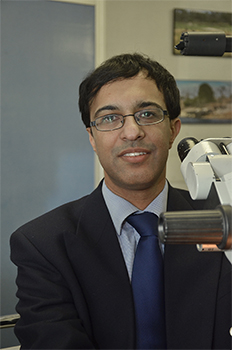Latest News Archive
Please select Category, Year, and then Month to display items
11 March 2021
|
Story Rulanzen Martin
|
Photo Courtesy of the artists
![]()
The annual final-year Fine Arts graduate exhibition promises to once again entice even the biggest of art enthusiasts. The exhibition, which runs until 1 April 2021, highlights the artworks/projects of final-year students in the Department of Fine Arts.
 Louiza Combrinck, World-building, Digital print, 84 x 49 cm. Image courtesy of the artist.
Louiza Combrinck, World-building, Digital print, 84 x 49 cm. Image courtesy of the artist.
 Final-year graduate exhibition at the Johannes Stegmann gallery
Final-year graduate exhibition at the Johannes Stegmann gallery
 Monique Myburgh, Digital Atoll I, Digital drawing, 70 x 100 cm. Image courtesy of the artist.
Monique Myburgh, Digital Atoll I, Digital drawing, 70 x 100 cm. Image courtesy of the artist.
 Elizabeth Bosch, Blau Macht mich Traurig, Oil on wood, 80 x 62.5 cm. Image courtesy of the artist.
Elizabeth Bosch, Blau Macht mich Traurig, Oil on wood, 80 x 62.5 cm. Image courtesy of the artist.
 Shenique Roux, Perplexed Recollection, Digital print, 40 x 100 cm. Image courtesy of the artist.
Shenique Roux, Perplexed Recollection, Digital print, 40 x 100 cm. Image courtesy of the artist.
Otorhinolaryngology research hopes to decrease morbidity
2016-10-04

Prof Riaz Seedat, Head of the
Department of
Otorhinolaryngology at the UFS
Prof Riaz Seedat, Head of the Department of Otorhinolaryngology at the UFS is a world-renowned ear, nose and throat specialist and researcher. He is also a National Research Foundation C3 rated scientist.
He is conducting his research in ear, nose and throat (ENT) pathology in a developing world setting, particularly focusing on recurrent respiratory papillomatosis and other ENT conditions. “This condition is caused by human papillomavirus (HPV), infective conditions as well as allergic rhinitis,” said Prof Seedat.
Current research is aimed at further describing the epidemiology of recurrent respiratory papillomatosis, identification of the HPV variants responsible for causing the condition and markers of disease aggressiveness.
The research has led to various international partnerships such as the multicentre collaborative studies, “Genetic Susceptibility to Papilloma-induced Voice Disturbance” at the Centre for Genomic Sciences at the Allegheny-Singer Research Institute in Pittsburgh, United States, and the HPV6/11 Global Diversity Consortium at the University of Ljubljana in Slovenia.
Although most head and neck squamous cell carcinomas are caused by excessive tobacco and alcohol use, there is an increasing body of evidence to show that HPV causes a subset of head and neck squamous cell carcinomas. However, there are few studies on the role of HPV in head and neck neoplasms in developing countries.
“Through the research we have shown that recurrent respiratory papillomatosis, caused by HPV, is not as rare in South Africa as it is in developed countries and that patients usually present respiratory papillomatosis at an advanced stage when the condition is life-threatening,” said Prof Seedat.
“It is hoped that this research will help us to address the morbidity caused by ENT conditions common in developing countries,” said Prof Seedat.